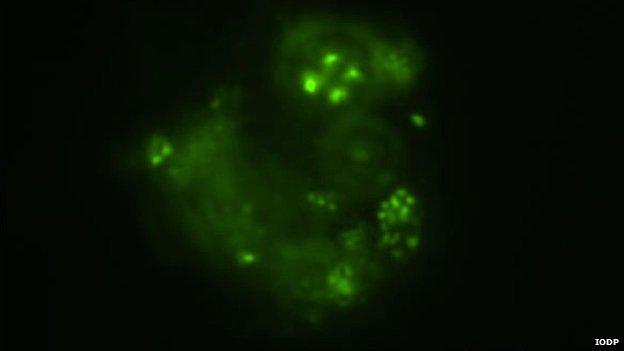Microbes discovered by deepest marine drill analysed
- Published

The small single-celled organisms expend very little energy
Life uncovered by the deepest-ever marine drilling expedition has been analysed by scientists.
The International Ocean Discovery Program (IODP) found microbes living 2,400m beneath the seabed off Japan.
The tiny, single-celled organisms survive in this harsh environment on a low-calorie diet of hydrocarbon compounds and have a very slow metabolism.
The findings are being presented at the America Geophysical Union Fall Meeting.
Elizabeth Trembath-Reichert, from the California Institute of Technology, who is part of the team that carried out the research, said: "We keep looking for life, and we keep finding it, and it keeps surprising us as to what it appears to be capable of."
The IODP Expedition 337 took place in 2012 off the coast of Japan’s Shimokita Peninsula in the northwestern Pacific.
From the Chikyu ship, a monster drill was set down more than 1,000m (3,000ft) beneath the waves, where it penetrated a record-breaking 2,446m (8,024ft) of rock under the seafloor.
Sluggish ways
Samples were taken from the ancient coal bed system that lies at this depth, and were returned to the ship for analysis.

Japan's Chikyu vessel has the ability to drill deep into the Earth's crust
The team found that microbes, despite having no light, no oxygen, barely any water and very limited nutrients, thrived in the cores.
To find out more about how this life from the "deep biosphere" survives, the researchers set up a series of experiments in which they fed the little, spherical organisms different compounds.
Dr Trembath-Reichert said: "We chose these coal beds because we knew there was carbon, and we knew that this carbon was about as tasty to eat, when it comes to coal, as you could get for microbes.
"The thought was that while there are some microbes that can eat compounds in coal directly, there may be smaller organic compounds – methane and other types of hydrocarbons - sourced from the coal that the microbes could eat as well."
The experiments revealed that the microbes were indeed dining on these methyl compounds.
The tests also showed that the organisms lived life in the slow lane, with an extremely sluggish metabolism.
They seem to use as little energy as possible to get by.
Other worlds
The researchers are now trying to work out if there are lots of different kinds of microbes living in the coal beds or whether there is one type that dominates.
They also want to find out how the microbes got there in the first place.
"Were these microbes just in a swamp, and loving life in a swamp, because there is all sorts of carbon available, oxygen, organic matter... and then that gets buried?" pondered Dr Trembath-Reichert.
"It could be that they didn’t get a chance to escape – they couldn’t exactly walk out. So is it that they were there to begin with and then they could maintain life?
"Or were they like microbes that were able to travel down to those depths from the surface?"
The discovery of vast ecosystems of microbes deeper and deeper underground is causing scientists to reassess the role that these organisms play in the carbon cycle.
Because these organisms take in hydrocarbons and expel methane, a greenhouse gas, as a waste product, they may be having a greater impact on the system that governs the Earth’s climate than was previously thought.
The findings also have implications for the hunt for life on other planets.
If life can survive in the most extreme conditions on Earth, perhaps it has found a way to cope with harsh environments elsewhere in the cosmos.

Everywhere we look, even in the harshest environments, life seems to find a way to survive
Follow Rebecca on Twitter, external
- Published5 April 2011
- Published24 March 2011